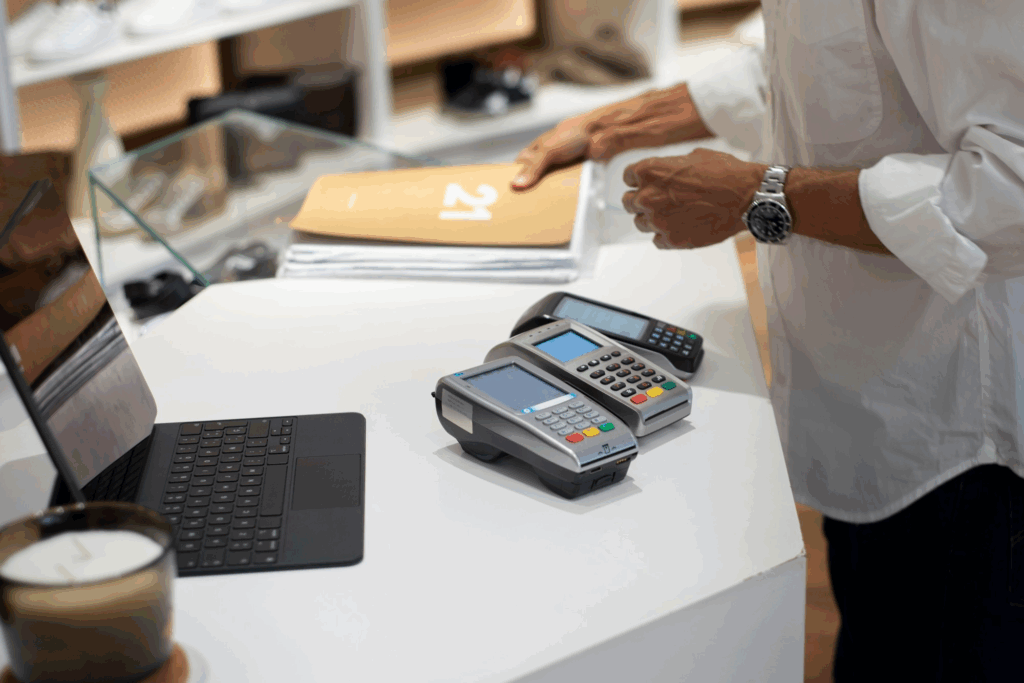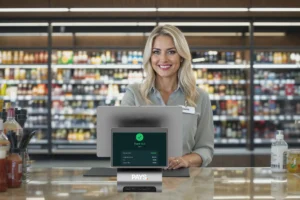
The POS Features That’ll Make or Break Your Business This Year
My neighbour Carl runs this little deli on Main Street. Great sandwiches, friendly service, been there for fifteen years. But last week, I watched him lose his mind because his cash register crashed right during lunch rush. Customers lined up out the door, and he’s frantically writing receipts by hand while everyone’s checking their watches.
That’s when Carl finally admitted what I’d been telling him for months – his ancient POS setup was killing his business. Not literally, but close enough.
See, I’ve been in the payment processing world for over a decade now. Started right out of college, worked with everyone from corner bakeries to mid-sized retailers. And here’s what nobody tells you about POS systems: the wrong choice doesn’t just inconvenience you. It slowly strangles your business to death.
But get the right features? Man, it’s like giving your business superpowers.
So let me tell you about the seven things that separate businesses that struggle from ones that absolutely crush it. Miss even one of these, and you’re basically playing with one hand tied behind your back.

Why This Stuff Actually Matters
Let me show you a scene. Two coffee shops on the same street. Same quality coffee, same prices, similar locations.
Shop A uses some basic POS system they bought five years ago. Takes forever to process payments, constantly runs out of popular items, and the owner has no clue what’s selling well.
Shop B upgraded to a modern system last year. Customers zip through the line, they never run out of the good stuff, and the owner actually takes vacations now because she can monitor everything from her phone.
Guess which one’s doing three times the revenue?
That’s the power of getting this decision right.
1. Cloud-Based Processing - Because You Can't Be Everywhere at Once
Alright, so “cloud-based” sounds like techno-babble, right? Here’s what it really means: instead of all your business data living on that one computer behind your counter (the one that crashes every time Windows updates), everything lives safely online.
Why should you care? Because running a business from one physical location is so 2019.
My client Susan owns two yoga studios. Last month, she was at her kid’s school play when she got a text alert – one studio was absolutely packed, but they were running low on water bottles and yoga mats. From her phone, in the middle of “Our Town” act two, she checked her other studio’s inventory and texted her manager to grab supplies.
She made an extra $400 that night selling retail items that would’ve been sold out otherwise. From a middle school auditorium.
Here’s what to look for in cloud systems:
Your data syncs instantly across all devices. Whether you check sales on your laptop at home or on your phone at the grocery store, you see the exact same information.
The system works even when your internet goes down. Because let’s face it, internet outages happen at the worst possible times.
Updates happen automatically overnight. You don’t shut down your business for three hours while some technician installs new software.
Everything gets backed up constantly. No more late nights to worry about server crashes.
Look, I get it. Some business owners worry about putting their data “in the cloud.” But here’s the truth – companies like Amazon and Google spend billions making sure their data centers are way more secure than whatever setup you’ve got in your back room.
2. Mobile Payments - Stop Saying "Cash Only" Like It's 1995
Last month, I was grabbing lunch at this great little Mediterranean place. Perfect food, reasonable prices, but when I went to pay with Apple Pay, the owner actually rolled his eyes and pointed to a handwritten sign: “Cash or card with chip only.”
I had my debit card with me, so no big deal. But the guy behind me? He literally walked out. Just left his order sitting there and went to Subway instead.
That’s a twenty-dollar sale that walked out the door because the owner decided customers should adapt to his system instead of the other way around.
Here’s what people actually want to pay with these days:
Apple Pay, Google Pay, Samsung Pay. This isn’t just for tech nerds anymore. My 67-year-old mother uses Apple Pay everywhere because it’s faster than digging through her purse for her card.
Tap-to-pay cards. You know, the ones where you just hold the card near the reader for half a second? Everyone under forty expects this to work.
Buy now, pay later options like Afterpay. Especially if you sell anything over fifty bucks. Younger customers love splitting purchases into payments.
Even QR codes for payments. Sounds weird, but it’s huge with both college students and older customers who don’t want to hand their cards to strangers.
Here’s the thing about payment methods – every time you say “we don’t take that,” you’re not just losing one sale. You’re losing that customer forever. They remember the hassle, and they don’t come back.
My friend Tony runs a small auto repair shop. He was hemorrhaging customers because he only took cash and traditional cards. After upgrading to accept everything, his revenue jumped 25% in four months. Not from raising prices – just from stopping the bleeding of customers who couldn’t pay the way they wanted to.
3. Inventory That Actually Tracks Itself - No More Guessing Games
This one’s personal for me because I’ve watched too many great business owners drive themselves crazy with inventory management.
My client Mike owned this fantastic hardware store. Great location, helpful staff, fair prices. But Mike was drowning. He spent every Sunday morning counting inventory with a clipboard, he could never have bestsellers on hand, and he filled a storage room with non-moving inventory over a two-year span.
Mike was working 70-hour weeks and barely making ends meet.
Then he switched to a POS system that automatically tracked everything. Every screwdriver sold, every can of paint moved, every delivery received – all tracked automatically.
Six months later? Mike’s working 45 hours a week, his profits are up 35%, and he actually went on vacation for the first time in five years.
Here’s what automatic inventory tracking actually does:
Alerts you before you run out. No more “Sorry, we just sold the last one” conversations with disappointed customers.
Shows you what’s actually making money. Mike discovered that paint brushes – which took up barely any shelf space – were generating 15% of his total profit.
Prevents overbuying. That expensive display of seasonal items that isn’t moving? Your system will tell you to clearance them out and use that space for something that actually sells.
Automatically creates purchase orders. When you hit minimum stock levels, the system can literally order replacement inventory for you.
The best part? Mike’s inventory is always accurate now. Before, he’d tell customers “let me check the back” and spend ten minutes searching for something that wasn’t even in stock. Now he knows instantly what’s available.
4. Reports That Actually Tell You What's Happening
Most small business owners run on gut feelings. “I think Tuesdays are slow.” “I think that new product is popular.” “I think we need more staff during lunch.”
But what if you actually knew instead of just thinking?
My client Jessica runs a small restaurant. For two years, she worried about serving meals because it seemed chaotic and unprofitable. Lots of customers, lots of work, but little money.
Then her new POS system showed her something shocking – lunch was actually her most profitable time period. The problem wasn’t too many customers or low prices. The problem was that she was scheduling her highest-paid employees during slower evening shifts and letting part-timers handle the lunch rush.
She flipped her scheduling around. Same restaurant, same food, same prices. But now she’s making an extra $6,000 per month because she finally knew what was actually happening in her business.
Here are the reports that actually matter:
Sales by time of day. You might discover that your “slow” period is actually when your highest-margin items sell.
Employee performance. Find out who your natural upsellers are and who might need additional training.
Product profitability. That cheap item you barely promote might be your biggest moneymaker.
Customer buying patterns. Learn that customers who buy one specific item are 5x more likely to become regulars.
The key is getting reports that are actually useful, not just pages of numbers that you never look at.
5. Multi-Location Features (Even If You Only Have One Store)
“I’ll cross that bridge when I get there” is what most single-location owners tell me about multi-location features.
Here’s why that’s a mistake: when growth opportunities come, they come fast. And if your system can’t handle expansion, you either miss the opportunity or turn your success into a management nightmare.
My client Kevin had one incredibly successful sandwich shop. When the perfect second location became available, he jumped on it. Great spot, good lease terms, excited staff ready to transfer.
But his POS system could only handle one location.
So Kevin ended up running two completely separate systems. Every night, he’d manually combine reports from both locations. He drove back and forth constantly because he couldn’t monitor the other store remotely.
What should have been his big breakthrough became a source of constant stress and extra costs.
Here’s what multi-location support gives you:
One dashboard for everything. See sales, inventory, and staff performance across all locations from anywhere.
Easy staff transfers. Employees can work at any location without learning different systems.
Centralized inventory management. Move products between locations based on demand instead of running out at one while overstocked at another.
Consistent customer experience. Same prices, same promotions, same loyalty program benefits no matter which location customers visit.
Even if you never expand, systems designed for multiple locations are usually more robust and feature-rich than single-location systems.
6. Loyalty Programs That People Actually Want to Join
Here’s a stat that’ll blow your mind: getting a new customer costs 5-7 times more than keeping an existing one. Yet most small businesses spend all their marketing budget chasing new customers while completely ignoring the ones they already have.
My client Maria’s coffee shop was the perfect example. Great location right off a busy highway, excellent coffee, friendly staff. But 90% of her customers were one-time travelers just passing through.
She was working harder and harder but barely growing because she was constantly starting from zero with new customers every day.
Then she implemented a simple loyalty program through her POS. Buy 9 coffees, get the 10th free. Nothing fancy, just a basic punch card program built into the system.
Within eight months, 45% of her revenue was coming from repeat customers. Her daily sales increased by $280 on average, but more importantly, her income became predictable. She could plan ahead, invest in better equipment, even take time off without panicking about cash flow.
Types of programs that actually work:
Point systems where customers earn rewards for every dollar spent. People love watching their points add up, and you can offer different reward levels to encourage bigger purchases.
Visit-based programs like “buy 10, get 1 free.” Classic for a reason – they’re simple to understand and create clear incentives to return.
VIP levels, where special privileges unlock after reaching a certain purchase amount, make customers feel valued and strive to reach the next level.
The psychology here is simple: people love feeling appreciated. When someone gets a notification that they’ve earned a free item, they don’t just feel good about the reward – they feel good about your business. That positive association is what brings them back.
7. Security That Actually Protects You
I’ve helped three business owners deal with data breaches. It’s absolutely brutal. Beyond the immediate costs – fines, legal fees, system repairs – there’s the stress, the angry customers, and reputation damage that can take years to recover from.
One small retailer I know got hit because their old POS system wasn’t properly secured. The fines alone were $18,000. Legal fees added another $12,000. But the real killer was losing 35% of their regular customers over the next year as word spread around their small town.
They survived, but barely. And it was completely preventable.
Here’s what security actually means in practical terms:
PCI compliance isn’t optional. If you process credit cards, you need this certification. Period. No exceptions, no “we’ll get around to it later.”
End-to-end encryption involves customer card data being encrypted from the point they insert their card to the end of a transaction. Even if someone steals this data, they are not able to utilize it.
Access controls equate to your Saturday afternoon cash clerk not having your level of system privileges. Everybody receives just the level of access they require to do their job, nothing more.
Background automatic security updates that do not interfere with your business operations. You shouldn’t have to shut down for hours while security patches get installed.
Two-factor authentication for admin access. Even if someone finds out your password, they still won’t be able to access your system without your phone.
Regular security checks are performed by specialists who know what to look for. Your POS provider should be proactively checking for vulnerabilities, not waiting until something goes wrong.
Here are the red flags that should terrify you:
Your POS provider can’t clearly explain their security measures in plain English.
Updates require shutting down your system during business hours.
They store credit card information anywhere in readable format.
They don’t offer two-factor authentication as an option.
Security is not something that can be upgraded later. It must be built into the system from the start.
How to Actually Pick the Right System
After helping hundreds of businesses choose POS systems, here’s the process that actually works:
Begin by accurately evaluating what you really need. Put down how many transactions you handle per day, what kind of payments your customers request, what inventory you hold on hand, and if you are going to grow at all?
Don’t just watch demos – actually use the systems. Have your staff try them during busy periods. Process real transactions. Test the features you’ll use most often.
Calculate the total cost over three years, not just the monthly fee. Include transaction processing fees (usually the biggest expense), hardware costs, training time, and integration fees.
Talk to current users, especially businesses similar to yours. Ask about hidden costs, customer service quality, and what they wish they’d known before switching.
The Expensive Mistakes I See All the Time
Choosing based purely on price. The cheapest monthly fee usually comes with the highest transaction fees or the most limitations.
Buying more systems than you need. You don’t need every feature that exists. Focus on these seven core capabilities and ignore the bells and whistles.
Underestimating the learning curve. Budget time and money for training. A system that nobody knows how to use properly is worthless.
Not planning for growth. That “simple” system might become a bottleneck when you’re processing twice as many transactions next year.
Ignoring customer service quality. When your POS system goes down during your busiest day, you need help immediately, not a ticket number and a promise to call you back.
What Happens Next
If you’re reading this and realizing your current POS system is missing several of these features, you’re not alone. Most business owners are working with outdated systems that are costing them money every single day.
Here’s what I recommend:
Audit your current system against these seven features. Be honest about what’s missing and what’s not working well.
Calculate what these missing features are actually costing you in lost sales, extra labor, and stress.
Test 2-3 modern systems that include all seven features. Don’t just take vendor’s word for it – actually use them.
Plan your switch during your slowest season so you have time to train staff and work out any kinks.
Stop Fighting Your POS System
Running a small business is challenging enough without your POS system making everything harder. The right features don’t just make your life easier – they make your business more profitable and give you the freedom to focus on what you do best.
I’ve watched too many talented business owners burn out because they were working twice as hard as necessary, fighting systems that should have been helping them succeed.
Don’t be one of them.




